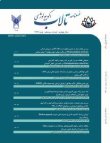Analysis of Al, Zn and Pb content in sediments and correlation with metals accumulation in benthic communities (Case study: Macrobenthos communities of Khor Musa)
Abstract:
Heavy metals are discharged into the marine environment through natural process and anthropogenic activities. They can remain in dissolved or in suspension in the water column, precipitate to the bottom, or be taken up by various marine organisms. So, metals can accumulate to toxic concentrations causing ecological damage, and subsequently be transferred to humans and terrestrial animals through the food and feed chains. Therefore this study was conducted for assessment of correlation between Al, Zn and Pb concentrations in macro benthos communities of Khor Musa and these metals accumulation in sediments in 2012. For sediments sampling, cores of 40 cm length were collected with the help of a PVC tube by gently intruding it into the sediment and protruding it out, capping, and freezing it upon return to the laboratory. After digesting the sediments with Aqua Regia solution 3/1 (v/v) HCl/HNO3 in microwave device and identifying the macrobenthos species, concentrations of heavy metals sediments and macro benthos samples were measured using ICP-AES. All statistical analyses were performed using the SPSS statistical package according to Shapiro-Wilk test, One Sample T test, One Way ANOVA (Duncan Multiple Range Test) and Pearson’s correlation coefficient. The results showed that maximum mean concentrations of Al, Zn and Pb in sediment samples were 620.29±80.0, 136.0±24.0 and 10.47±3.0 mg/kg respectively, and maximum mean concentrations of these elements in macro benthos samples were 8510.11±619.40, 48.76±5.32 and 24.0±3.99 mg/kg respectively belonged to Bivalvia, Gastropoda and Crustacea. The mean concentrations of Zn and Pb were significantly lower than permissible limits recommended by WHO (P<0.05). Also significant correlation found between mean concentration of Pb in sediment samples and Gastropoda samples. Although currently the sediments of study area aren't polluted with Zn and Pb, but the establishment of the petroleum industries, ship traffic, the oil spill from drilling rigs and tankers discharging ballast water can cause a threat to sediments pollution and consequently aquatic animals of this area.
Keywords:
Language:
Persian
Published:
Journal of Wetland Ecobiology, Volume:9 Issue: 1, 2017
Pages:
17 to 28
https://magiran.com/p1977328
دانلود و مطالعه متن این مقاله با یکی از روشهای زیر امکان پذیر است:
اشتراک شخصی
با عضویت و پرداخت آنلاین حق اشتراک یکساله به مبلغ 1,390,000ريال میتوانید 70 عنوان مطلب دانلود کنید!
اشتراک سازمانی
به کتابخانه دانشگاه یا محل کار خود پیشنهاد کنید تا اشتراک سازمانی این پایگاه را برای دسترسی نامحدود همه کاربران به متن مطالب تهیه نمایند!
توجه!
- حق عضویت دریافتی صرف حمایت از نشریات عضو و نگهداری، تکمیل و توسعه مگیران میشود.
- پرداخت حق اشتراک و دانلود مقالات اجازه بازنشر آن در سایر رسانههای چاپی و دیجیتال را به کاربر نمیدهد.
In order to view content subscription is required
Personal subscription
Subscribe magiran.com for 70 € euros via PayPal and download 70 articles during a year.
Organization subscription
Please contact us to subscribe your university or library for unlimited access!



